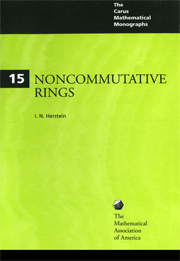AFTERWORD
Summary
Noncommutative Rings is a classic. It is fair to say that almost every practicing ring theorist has, at some time, studied portions of this book. Herstein's style and grace make ring theory especially attractive. In this reprinting we have not changed text—only corrected typos. There are no additional chapters or remarks in the body of the text.
However, we do want to add a few remarks as a guide to the current literature and an indication of some of the enormous development in ring theory since Noncommutative Rings appeared.
The theory of rings satisfying a polynomial identity had a huge “pay-off” when Amitsur, in 1971, produced a finitedimensional algebra that is not a crossed product. Polynomial identity theory itself was dramatically changed by Formanek's and Razmyslov's discovery of central polynomials around the same time. For an account of all of this, see Rowen's book [4].
Noetherian ring theory experienced a dramatic development with substantial applications to the study of enveloping algebras of finite-dimensional Lie algebras. The vade mecum of Noetherian rings is the volume of McConnell and Robson [2]. For a crisp exposition, see also the monograph of Goodearl and Warfield [1].
Ring theory and its methods have had an impact in other areas as well. “Actions” on rings and algebras, modem invariant theory, are active areas of interest; see the recent monograph of Montgomery [3].
- Type
- Chapter
- Information
- Noncommutative Rings , pp. 201 - 202Publisher: Mathematical Association of AmericaPrint publication year: 1968



